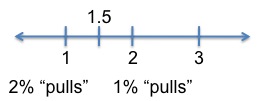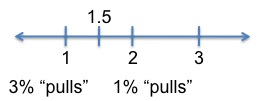-
Target Test Prep 20% Off Flash Sale is on! Code: FLASH20
Redeem
Breaking Down GMATPrep Average + Arithmetic Problems
 In the past, weve discussed weighted average Data Sufficiency problems (twice: first here and then here) and weve also discussed how to turn algebra problems into arithmetic problems. This week, were going to put these concepts together. Weve got a GMATPrep weighted average Problem Solving question that qualifies for the arithmetic method.
In the past, weve discussed weighted average Data Sufficiency problems (twice: first here and then here) and weve also discussed how to turn algebra problems into arithmetic problems. This week, were going to put these concepts together. Weve got a GMATPrep weighted average Problem Solving question that qualifies for the arithmetic method.
Weighted average problems on the GMAT are more often DS questions, but they can appear in PS format as well (as we see below). Decide whether you want to read the previous two articles first, in order to get a better idea of how these problems work. Or try the below first and only go back to the two previous articles if you think you need to (or want to) after youre done.
Heres the GMATPrep problem. Set your timer for 2 minutes. and GO!
Three grades of milk are 1 percent, 2 percent, and 3 percent fat by volume. If x gallons of the 1 percent grade, y gallons of the 2 percent grade, and z gallons of the 3 percent grade are mixed to give x + y + z gallons of a 1.5 percent grade, what is x in terms of y and z?(A) y + 3z
(B) [pmath]{y+z}/4[/pmath]
(C) 2y + 3z
(D) 3y + z
(E) 3y + 4.5z
There are three kinds of milk: 1% milk, 2% milk, and 3% milk. These are our three sub-groups. When the three are combined (in some unknown amounts), we get a 4th kind:1.5% milk. The number of gallons of 1% milk (x), the number of gallons of 2% milk (y) and the number of gallons of 3% milk (z) will add up to the number of gallons of 1.5% milk (x + y + z). Were supposed to figure out what x is, but not the actual value of x rather, were supposed to figure out x in terms of, or using, y and z.
This problem never mentions the word "average". Thats annoying how are we supposed to tell that this is a weighted average problem? Basically, the problem should talk about 2 or 3 sub-groups that are combined in some way to make an overall group, or mixture of the original sub-groups. The problem will often discuss these groups in terms of percentages (as this problem does) or ratios. That starts to tell us that some kind of averaging is happening.
Next, we glance at the answers and notice that there are variable expressions there. Excellent! That means that we can turn this problem into an arithmetic problem if we want we can choose real numbers. As a general rule, we want to do this on harder questions, and weighted average questions tend to be harder questions. Note that there is a super shortcut on this problem, but you really have to understand how weighted averages work in order to use it. So, first, were going to talk about the longer arithmetic method.
Now, we have to come up with some numbers for our variables. Are we going to pick numbers for all three of the variables? Or only for some of them? How do we know?
We need to pick numbers for two of the variables and then do some math; that math will determine the value for the third variable. Which variables do you think would be the easiest ones to use? What kinds of numbers do we need to pick?
The overall average is 1.5% milk, so are we going to need more of the 1% milk, the 2% milk, or the 3% milk? We need more of the 1% than the other two, because its the only one that pulls the average down. Were figuring this out just so that we have a reality check on the problem that will help us pick numbers and also help us know if we did something wrong (for instance, if the calculation tells us that the amount of 1% milk is not the greatest).
Next, we should make use of the fact that the problem asks us to figure out x in terms of, or using, y and z. We can pick nice numbers for two of the variables, but were not sure what kind of number well get for the third it might be a fraction. Were eventually going to have to plug the values for y and z into the answers. So, lets pick nice numbers for y and z; it wont matter as much if x is not as nice a number.
Lets say we have 2 gallons of z (the 3% milk) and 4 gallons of y (the 2% milk), and x gallons of the 1% milk. Total, we have 6 + x gallons of milk. The weighted average is:
[pmath]{x(1)+4(2)+2(3)}/{6+x}=1.5[/pmath]
The numerator consists of each type of milk (1, 2, and 3) multiplied by the number of gallons of that type of milk. Note that I didnt write the three percentages as actual percentages. We just need to keep all of the percentages in the same form 1, 2, 3, and the average percentage, 1.5.
The denominator consists of the total number of gallons: x + 4 + 2, or x + 6.
Now, lets solve for x! First, lets cross-multiply:
[pmath]x+8+6=9+1.5x[/pmath]
[pmath]14-9=1.5x-x[/pmath]
[pmath]5=0.5x[/pmath]
[pmath]x=10[/pmath]
Hey, x turned out to be an easy number thats great! (Note: these really were the first numbers that I tried and I didnt even try to find something that would make x nice; I just got lucky. If I hadnt gotten a nice number for x, I wouldnt have cared. Id just keep going with the below.)
Now, Im going to test y=4 and z=2 in the answer choices, looking for the value 10.
(A) y + 3z = 4 + 3(2) = 10 Bingo!
(B) (y+z)/4=(4+2)/4<>10 (stop calculating when you can tell it wont be 10)
(C) 2y + 3z = 2(4) + 3(2) = too big
(D) 3y + z = 3(4) + stop! too big
(E) 3y + 4.5z = 3(4) + stop! too big
The correct answer is A.
Okay, do you want the super shortcut? If you havent yet read the second of the two previous weighted average articles (linked at the beginning of this article), do so now. Im not going to explain fully how this all works here its already in the other article. First, draw a number line that represents what we know to start:

We have three different kinds of milk to start, represented by the three numbers underneath the number line. The desired (final) weighted average is represented by the number on top, 1.5.
The 1% milk has to pull the average toward it and away from the 2% and 3% milks. Compare the 1% and 2% milk first. The 1% milk pulls the average 0.5 units away from 2 and towards 1, so the 1% milks weighting relative to the 2% milk is 0.5. Likewise, the 2% milk, pulls the average 0.5 units away from 1 and towards 2, so the 2% milks weighting relative to the 1% milk is 0.5. In other words, we need equal amounts of these two milks, x and y. If we have 2x, then we have 2y, and so on.

Now, lets compare the 1% and 3% milk. The 1% milk pulls the average 1.5 units away from 3 and towards 1, so the 1% milks weighting relative to the 3% milk is 1.5. The 3% milk pulls the average 0.5 units away from 1 and towards 3, so the 3% milks weighting relative to the 1% milk is 0.5. In other words, we have 3 times as much x as we do z, because 1.5 is three times 0.5.

If we want to represent y in terms of x, its easy: the two are equal, so we can just use y in place of x. If we want to represent z in terms of x, its just a little trickier. We want x to be three times greater than z, so we would write x = 3z. Do these terms look at all familiar? Go back and look at answer A: its y + 3z. Done!
Key Takeaways for Problem Solving Average + Arithmetic Problems:
(1) Determine that you have a weighted average problem: this occurs when an average is described (even if the word average is not in the problem!), but that average is not a standard 1:1 or equally weighted average.
(2) Determine that you can turn this problem into arithmetic. This occurs when the answer choices contain variable expressions (no equals sign or inequality). Also, know how to decide whether you want to do so. Typically, the harder the algebra for you, the easier it will be to do arithmetic instead. Most weighted average problems are on the more difficult side.
(3) If you feel very comfortable with weighted averages, you can also use the super shortcut number line method. Note that its very easy to make mistakes with this shortcut; use the arithmetic method if you dont feel very comfortable with the concepts underlying weighted averages.
* GMATPrep questions courtesy of the Graduate Management Admissions Council. Usage of this question does not imply endorsement by GMAC.
Recent Articles
Archive
- April 2024
- March 2024
- February 2024
- January 2024
- December 2023
- November 2023
- October 2023
- September 2023
- July 2023
- June 2023
- May 2023
- April 2023
- March 2023
- February 2023
- January 2023
- December 2022
- November 2022
- October 2022
- September 2022
- August 2022
- July 2022
- June 2022
- May 2022
- April 2022
- March 2022
- February 2022
- January 2022
- December 2021
- November 2021
- October 2021
- September 2021
- August 2021
- July 2021
- June 2021
- May 2021
- April 2021
- March 2021
- February 2021
- January 2021
- December 2020
- November 2020
- October 2020
- September 2020
- August 2020
- July 2020
- June 2020
- May 2020
- April 2020
- March 2020
- February 2020
- January 2020
- December 2019
- November 2019
- October 2019
- September 2019
- August 2019
- July 2019
- June 2019
- May 2019
- April 2019
- March 2019
- February 2019
- January 2019
- December 2018
- November 2018
- October 2018
- September 2018
- August 2018
- July 2018
- June 2018
- May 2018
- April 2018
- March 2018
- February 2018
- January 2018
- December 2017
- November 2017
- October 2017
- September 2017
- August 2017
- July 2017
- June 2017
- May 2017
- April 2017
- March 2017
- February 2017
- January 2017
- December 2016
- November 2016
- October 2016
- September 2016
- August 2016
- July 2016
- June 2016
- May 2016
- April 2016
- March 2016
- February 2016
- January 2016
- December 2015
- November 2015
- October 2015
- September 2015
- August 2015
- July 2015
- June 2015
- May 2015
- April 2015
- March 2015
- February 2015
- January 2015
- December 2014
- November 2014
- October 2014
- September 2014
- August 2014
- July 2014
- June 2014
- May 2014
- April 2014
- March 2014
- February 2014
- January 2014
- December 2013
- November 2013
- October 2013
- September 2013
- August 2013
- July 2013
- June 2013
- May 2013
- April 2013
- March 2013
- February 2013
- January 2013
- December 2012
- November 2012
- October 2012
- September 2012
- August 2012
- July 2012
- June 2012
- May 2012
- April 2012
- March 2012
- February 2012
- January 2012
- December 2011
- November 2011
- October 2011
- September 2011
- August 2011
- July 2011
- June 2011
- May 2011
- April 2011
- March 2011
- February 2011
- January 2011
- December 2010
- November 2010
- October 2010
- September 2010
- August 2010
- July 2010
- June 2010
- May 2010
- April 2010
- March 2010
- February 2010
- January 2010
- December 2009
- November 2009
- October 2009
- September 2009
- August 2009